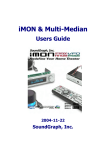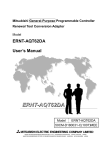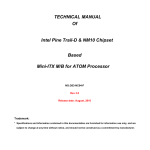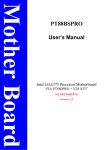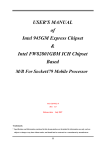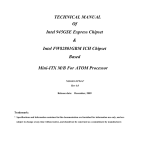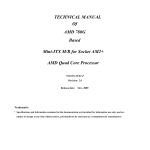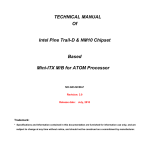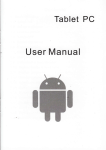Download User`s Manual
Transcript
TECHNICAL MANUAL Of VIA VX800 Based Mini-ITX M/B For VIA C7/Eden/Nano Processor NO.G03-NF77-F Rev.2.0 Release date: December, 2008 Trademark: * Specifications and Information contained in this documentation are furnished for information use only, and are subject to change at any time without notice, and should not be construed as a commitment by manufacturer. Environmental Protection Announcement Do not dispose this electronic device into the trash while discarding. To minimize pollution and ensure environment protection of mother earth, please recycle. ii TABLE OF CONTENT USER’S NOTICE .................................................................................................................................. iv MANUAL REVISION INFORMATION ............................................................................................ iv ITEM CHECKLIST.............................................................................................................................. iv CHAPTER 1 INTRODUCTION OF MOTHERBOARD 1-1 FEATURE OF MOTHERBOARD..............................................................................……1 1-2 SPECIFICATION.................................................................................................................. 2 1-3 LAYOUT DIAGRAM & JUMPER SETTING ................................................................... 3 CHAPTER 2 HARDWARE INSTALLATION 2-1 JUMPER SETTING .............................................................................................................. 7 2-2 CONNECTORS AND HEADERS ....................................................................................... 10 2-2-1 CONNECTORS....................................................................................................... 10 2-2-2 HEADERS ............................................................................................................... 10 CHAPTER 3 INTRODUCING BIOS 3-1 ENTERING SETUP .............................................................................................................. 16 3-2 GETTING HELP ................................................................................................................... 16 3-3 THE MAIN MENU................................................................................................................ 16 3-4 STANDARD BIOS FEATURES........................................................................................... 18 3-5 ADVANCED BIOS FEATURES.......................................................................................... 20 3-5-1 CPU FEATURE....................................................................................................... 23 3-6 ADVANCED CHIPSET FEATURES .................................................................................. 23 3-6-1 DRAM TIMING SETTINGS ................................................................................. 24 3-6-2 VGA TIMING SETTINGS..................................................................................... 25 3-6-3 PCI TIMING SETTINGS....................................................................................... 25 3-7 INTEGRATED PERIPHERALS ......................................................................................... 26 3-7-1 ONBOARD IDE FUNCTION................................................................................. 26 3-7-2 ONBOARD DEVICE FUNCTIONS...................................................................... 27 3-7-3 ONBOARD SUPERIO FUNCTIONS.................................................................... 28 3-7-4 USB DEVICE SETTINGS ...................................................................................... 30 3-8 POWER MANAGERMENT SETUP................................................................................... 31 3-9 PNP/PCI CONFIGURATION .............................................................................................. 32 3-10 PC HEALTH STATUS.......................................................................................................... 33 3-11 MISCELLANEOUS CONTROL ......................................................................................... 34 iii 3-12 PASSWORD SETTING ........................................................................................................ 35 3-13 LOAD STANDARD/OPTIMIZED DEFAULTS ................................................................ 36 USER’S NOTICE COPYRIGHT OF THIS MANUAL BELONGS TO THE MANUFACTURER. NO PART OF THIS MANUAL, INCLUDING THE PRODUCTS AND SOFTWARE DESCRIBED IN IT MAY BE REPRODUCED, TRANSMITTED OR TRANSLATED INTO ANY LANGUAGE IN ANY FORM OR BY ANY MEANS WITHOUT WRITTEN PERMISSION OF THE MANUFACTURER. THIS MANUAL CONTAINS ALL INFORMATION REQUIRED TO USE VIA VX800 CHIPSET MOTHER-BOARD SERIES AND WE DO ASSURE THIS MANUAL MEETS USER’S REQUIREMENT BUT WILL CHANGE, CORRECT ANY TIME WITHOUT NOTICE. MANUFACTURER PROVIDES THIS MANUAL “AS IS” WITHOUT WARRANTY OF ANY KIND, AND WILL NOT BE LIABLE FOR ANY INDIRECT, SPECIAL, INCIDENTIAL OR CONSEQUENTIAL DAMAGES (INCLUDING DAMANGES FOR LOSS OF PROFIT, LOSS OF BUSINESS, LOSS OF USE OF DATA, INTERRUPTION OF BUSINESS AND THE LIKE). PRODUCTS AND CORPORATE NAMES APPEARING IN THIS MANUAL MAY OR MAY NOT BE REGISTERED TRADEMARKS OR COPYRIGHTS OF THEIR RESPECTIVE COMPANIES, AND THEY ARE USED ONLY FOR IDENTIFICATION OR EXPLANATION AND TO THE OWNER’S BENEFIT, WITHOUT INTENT TO INFRINGE. Manual Revision Information Reversion 2.0 Revision History Second Edition Date December, 2008 Item Checklist 5 5 5 5 5 Motherboard Cable(s) CD for motherboard utilities Motherboard User’s Manual I/O Back panel Shield iv Chapter 1 Introduction of the Motherboard 1-1 Feature of motherboard * VIA VX800 chipset. *Onboard optional C7/Eden/Nano CPU, with low power consumption and never denies high performance. * Support optional FSB 400/533 /800MHz. * Support DDRII 400/533/667 up to 2GB. * Onboard REALTEK RTL 8111C Gigabit Ethernet LAN. * Integrated VIA 1708 B 6-channel HD audio CODEC * Support USB2.0 data transport demands. 1 1-2 Specification Spec Design Chipset Embedded CPU Memory Socket x Expansion Slots Description ∗ Mini ITX form factor 4 layers PCB size: 17.0x17.0cm ∗ VIA VX800 Chipset ∗ Optional VIA C7 /Eden/Nano seriesCPU ∗ 240-pin DDRII DIMM socket x1 ∗ Support DDRII 400/533/667MHz system Modules DDR memory ∗ Expandable to 2GB. ∗ 32-bit PCI slot x 1pcs ∗ Integrate IDE LAN Audio BIOS Multi I/O ∗ ∗ ∗ ∗ ∗ ∗ ∗ ∗ ∗ ∗ ∗ ∗ ∗ ∗ One PCI IDE controller that supports PCI Bus Mastering, ATA PIO/DMA and the ULTRA DMA 133/100/66 functions that deliver the data transfer rate up to 133 MB/s; Integrated Realtek RTL8111C PCI-E LAN chip. Support Fast Ethernet LAN function of providing 10Mb/100Mb/1000Mb Ethernet data transfer rate VIA 1708B 6-channel Audio Codec integrated Audio driver and utility included Award 4MB Flash ROM PS/2 keyboard and PS/2 mouse connectors Serial port connector x1/Parallel connector x1 VGA connectorx1 USB2.0 port x 4 RJ45 LAN connector x1 Audio connector x1 (Line-in, Line-out, MIC/ 6CH Audio) LVDS inverter connector x1 LCD header x1 COM header x 3 2 ∗ ∗ ∗ ∗ ∗ ∗ 1-3 IR header x1 Wi-Fi header x1 Audio header x 1/ CDIN header x1 Front Panel header x1 Hard disk drive connector x1 SATAII connector x2 Layout Diagram RJ45 LAN Parallel Port Connector Line-In PS/2 Mouse Line-Out PS/2 Keyboard MIC-IN Serial Port Connector USB USB VGA Connector Connector Connector 3 Keyboard/ USB Power (JP2) ATX Power Connector PS2 KB/Mouse Port JP8 Parallel Port Connector over Serial Port Connector & VGA connector Serial Port Header VIA C7/Eden/Nano Series CPU CPU FAN SYS FAN1 DDRII Socket x1 JP5 LVDS Inverter USB Port Connector RealtekRTL8111C Gigabit Lan RJ-45 over USB Connector Audio Connector CD Audio-In Header IR Connector VIA VX800 LVDS Header SATAII Connectors JP4 JP3 IDE Connector Serial Port Headers Speaker connector Power LED VIA 1708B Front Panel Audio Wi-Fi Header PCI Slot 4 JBAT SYS FAN2 Front Panel Header Jumper Jumper JP2 JBAT JP3 JP4 JP5 JP8 Name KB/USB Power On Function Setting CMOS RAM Clear Function Setting USB Power On Function Setting LVDS Voltage 5V/3.3V Select LVDS Inverter Power On Setting Power RS232 Function Select Description 3-pin Block 3-pin Block 3-pin Block 3-pin Block 3-pin Block 6-pin Block Page P.7 P.7 P.8 P.8 P.9 P.9 Connectors Connector PS2KBMS1 COM1 VGA PARALLEL USB1,USB2 RJ-45 from UL2 AUDIO1 IDE1 SATA1,2 Name Keyboard & Mouse Connector Serial Port Connector Video Graphic Attach Connector Parallel Port Connector USB Port Connector RJ-45 LAN Connector Line-Out /MIC/Line-In Audio Connector IDE Hard Disk Drive Connector Serial ATA Connectors 5 Description 6-pin Female Connector 9-pin Connector D-sub 15-pin Female 25-Pin Connector 4-pin Connector 8-pin Connector 3 Phone Jack 40-pin IDE Block 7-pin Connector Page p.10 p.10 p.10 p.10 p.10 p.10 p.10 Headers Header Name Description AUDIO Front panel audio Headers 9-pin block CDIN CD Audio-In Header 4-pin Block Serial Port COM1 Connector 9-pin Block COM 2,3,4 WI-FI Wi-Fi Header 11-pin Block LCD LVDS Connector 32-pin Block Inverter LVDS Inverter Connector 7-pin Block IR IR infrared module Headers 5-pin Block SPEAK Speaker Header 3-pin Block PWR LED Power LED 4-pin Block JW_FP Front Panel Header 9-pin Block (PWR LED/ IDE LED/ (PWR LED/ IDE LED/ /Power Button /Power Button /Reset) /Reset) SFAN1, SFAN2,CPU FAN Headers 3-pin Block FAN 6 Page P.11 P.12 p.12 P.13 P.13 P.14 P.15 P.15 P.16 P.16 P.16 Chapter 2 2-1 Jumper Setting (1) JP2: KB/USB Power On Function Setting 1 3 1 JP2 3 JP2 1-2 K.B&USBPOWER-ON Disacled(default) 2-3 K.B& USB POWER-ON Enabled (2) JBAT : Clear CMOS (3-pin) 1 JBAT 1 JBAT 3 1-2 closed Normal 3 2-3 closed CMOS RAM Clear Setting 7 Clear CMOS (3) JP3: USB Power On Function Setting (3-pin) 1 3 1 JP3 1-2 USB Power-on Disacled(default) 2-3 USB Power-on Enabled (4) JP4: LVDS VDD setting (3-pin) 1 3 JP4 1-2 closed: 1 JP4 5V 2-3 closed : 3.3V LVDS VDD setting 8 3 JP3 3 (5) JP5: LVDS Inverter Backlight Setting (3-pin) JP5 1 1 JP5 3 1-2 closed: 3 Off 2-3 closed : On LVDS Inverter Backlight Setting (6) JP8: Powered RS232 Function Select 1 1 1 JP8 1-2 closed: RS232 9 3-4 closed : +12V 5-6 closed : +5V 2-2 Connectors and Headers 2-2-1 Connectors (1) I/O Back Panel Connector RJ45 LAN Parallel Port Connector Line-In PS/2 Keyboard Line-Out PS/2 Mouse MIC-IN Serial Port Connector USB USB VGA Connector Connector Connector 2-2-2 Headers AUDIO LINE2-JD MIC2-JD KEY Audio-GND Audio-JD (1) Front panel audio header (9-pin): AUDIO 2 10 Pin 1 Sense-FB Lineout2-L Lineout2-R MIC2-L MIC2-R 9 Line-Out, MIC Headers 10 (2) CD AUDIO-In Headers (4-pin): CDIN 1 CD-L 4 GND GND CD-R CD Audio-In Headers (3) COM Connectors (9-pin): COM2/COM3/COM4 Pin1 DCD RXD TXD DTR GND DSR RTS GTS RI Serial Port 9-pin Block (4)Wi-Fi header: WI-FI This header supports WI-FI Function. Connect the wireless local area network adapter to this header. It allows you to create a wireless environment and enjoy the convenience of wireless network connectivity. 11 N.C +3.3V USB+5 D1D1+ GND WI-FI 2 12 Pin 1 WI-FI Headers (5)LVDS Headers: LCD CN1 LVDS Headers Pin NO. Pin Pin Define NO. Pin 1 R2IN3- Pin 2 R2IN3+ Pin 3 CK2IN- Pin 4 CK2IN+ Pin 5 R2IN2- Pin 6 R2IN2+ Pin 7 R2IN1- Pin 8 R2IN1+ Pin 9 R2IN0- Pin 10 R2IN0+ Pin 11 GND Pin 12 GND Pin 13 GND Pin 14 GND Pin 15 GND Pin 16 GND Pin 17 R1IN3+ Pin 18 R1IN3- Pin 19 CK1IN+ Pin 20 CK1IN- Pin 21 R1IN2+ Pin 22 R1IN2- Pin 23 R1IN1+ Pin 24 R1IN1- Pin 25 R1IN0+ Pin 26 R1IN0- Pin 27 VDD Pin 28 VDD Pin 29 VDD Pin 30 VDD Pin 31 GND Pin 32 GND 12 Pin Define N.C USB+5 D0D0+ GND 11 (6)Pin-headers of LVDS Inverter: INVERTER Pin 1 LVDS Inverter PIN No. Symbol 1 +12VIN 2 +12VIN 3 GND 4 GND 5 LVDS Panel backlight enable 6 GND 7 Panel backlight brightness control (7) IR infrared module Headers (5-pin): IR GND IRRX IR 2 6 5 NC +5V IRTX Pin 1 IR infrared module Header 13 (8) Speaker Header & Power Led Header(9-pin): SPEAK/ PWRLED PWRLED Pin 1 SPEAK NC GND VCC5 SPKR Pin 1 SPEAK & PWRLED Header PWRBTN GND GND RSTSW NC PWRBTN PWRLED JW FP HDDLE VCC5 PWR LED (9) Front Panel Header(9-pin): JW_FP RESET HDLED VCC5 Pin 1 Front Panel Headers 14 (10) FAN Speed Headers (3-pin): CPUFAN, SFAN1/SFAN2 +12v Fan Fan GND power clock 3 1 Fan Headers Chapter 3 Introducing BIOS The BIOS is a program located on a Flash Memory on the motherboard. This program is a bridge between motherboard and operating system. When you start the computer, the BIOS program will gain control. The BIOS first operates an auto-diagnostic test called POST (power on self test) for all the necessary hardware, it detects the entire hardware device and configures the parameters of the hardware synchronization. Only when these tasks are completed done it gives up control of the computer to operating system (OS). Since the BIOS is the only channel for hardware and software to communicate, it is the key factor for system stability, and in ensuring that your system performance as its best. In the BIOS Setup main menu of Figure 3-1, you can see several options. We will explain these options step by step in the following pages of this chapter, but let us first see a short description of the function keys you may use here: • Press <Esc> to quit the BIOS Setup. 15 • Press ↑ ↓ ← → (up, down, left, right) to choose, in the main menu, the option you want to confirm or to modify. • Press <F10> when you have completed the setup of BIOS parameters to save these parameters and to exit the BIOS Setup menu. • Press Page Up/Page Down or +/– keys when you want to modify the BIOS parameters for the active option. 3-1 Entering Setup Power on the computer and by pressing <Del> immediately allows you to enter Setup. If the message disappears before your respond and you still wish to enter Setup, restart the system to try again by turning it OFF then ON or pressing the “RESET” button on the system case. You may also restart by simultaneously pressing <Ctrl>, <Alt> and <Delete> keys. If you do not press the keys at the correct time and the system does not boot, an error message will be displayed and you will again be asked to Press <F1> to continue, or <Del> to enter Setup 3-2 Getting Help Main Menu The on-line description of the highlighted setup function is displayed at the bottom of the screen. Status Page Setup Menu/Option Page Setup Menu Press F1 to pop up a small help window that describes the appropriate keys to use and the possible selections for the highlighted item. To exit the Help Window, press <Esc>. 3-3 The Main Menu Once you enter Award® BIOS CMOS Setup Utility, the Main Menu (Figure 3-1) will appear on the screen. The Main Menu allows you to select from fourteen setup functions and two 16 exit choices. Use arrow keys to select among the items and press <Enter> to accept or enter the sub-menu. Phoenix – AwardBIOS CMOS Setup Utility Standard CMOS Features Miscellaneous Control Advanced BIOS Features Load Optimized Defaults Advanced Chipset Features Load standard Defaults Integrated Peripherals Set Supervisor Password Power Management Setup Set User Password PnP/PCI Configurations Save & Exit Setup PC Health Status Exit Without Saving Esc : Quit F10 : Save & Exit Setup ↑↓→← : Select Item Figure 3-1 Standard CMOS Features Use this Menu for basic system configurations. Advanced BIOS Features Use this menu to set the Advanced Features available on your system. Advanced Chipset Features Use this menu to change the values in the chipset registers and optimize your system’s performance. Integrated Peripherals Use this menu to specify your settings for integrated peripherals. Power Management Setup Use this menu to specify your settings for power management. 17 PnP/PCI Configuration Use this menu to specify your settings for PnP and PCI configurations. PC Health Status This entry shows your PC health status. Miscellaneous Control Use this menu to specify your settings for Miscellaneous Control. Load Optimized Defaults Use this menu to load the BIOS default values these are setting for optimal performances system operations for performance use. Load Standard Defaults Use this menu to load the BIOS default values for the minimal/stable performance system operation Set Supervisor Password Use this menu to set supervisor password. Set User Password Use this menu to set user password. Save & Exit Setup Save CMOS value changes to CMOS and exit setup. Exit Without Saving Abandon all CMOS value changes and exit setup. 3-4 Standard CMOS Features The items in Standard CMOS Setup Menu are divided into several categories. Each category includes no, one or more than one setup items. Use the arrow keys to highlight the item and then use the <PgUp> or <PgDn> keys to select the value you want in each item. 18 Phoenix – AwardBIOS CMOS Setup Utility Standard CMOS Features Date (mm:dd:yy) Time (hh:mm:ss) > IDE Channel0 > IDE Channel0 > IDE Channel 1 > IDE Channel 1 Video Halt On Base Memory Extended Memory Total Memory Wed, Aug13, 2008 16 : 48 : 35 Master None Slave None Master None Slave None EGA/VGA All, But keyboard 1664k 392192k 393216k Item Help Menu Level > Change the day, month, year and century ↑↓→← Move Enter:Select +/-/PU/PD:Value F10:Save ESC:Exit F1:General Help F5:Previous Values F6:Optimized Defaults F7:Standard Defaults Date The date format is <day><month><date><year>. Day Day of the week is from Sun to Sat, determined by BIOS. Read-only. The month is from Jan. through Dec. Month The date from 1 to 31 can be keyed by numeric function keys. Date The year depends on the year of the BIOS. Year Time The time format is <hour><minute><second>. IDE Channel 0/1 Master/Slave Press Enter and then PgUp/<+> or PgDn/<–> to select Manual, None, Auto type. Note that the specifications of your drive must match with the drive table. The hard disk will not work properly if you enter improper information for this category. If the type of hard disk drives is not matched or listed, you can use Manual to define your own drive type manually. If you select Manual, related information is asked to be entered to the following items. Enter the information directly from the keyboard. This information should be provided in the documentation from your hard disk vendor or the system manufacturer. If the controller of HDD interface is SCSI, the selection shall be “None”. 19 If the controller of HDD interface is CD-ROM, the selection shall be “None” Access Mode The settings are CHS, LBA, Large and Auto. number of cylinders Cylinder number of heads Head write precomp Precomp Landing Zone landing zone number of sectors Sector 3-5 Advanced BIOS Features Phoenix – AwardBIOS CMOS Setup Utility Advanced BIOS Features CPU Feature Press Enter Item Help Hard Disk Boot Priority Press Enter Virus Warning Disabled CPU L1&L2 Cache Enabled Menu Level > CPU L2 Cache ECC Checking Enabled Quick power on self Test Enabled First Boot Device CDROM Second Boot Device HARD DISK Third Boot Device LS120 Boot other Device Enabled Boot Up NumLock Status On Typematic Rate Setting Disabled Typematic Rate (Chars/Sec) 6 Typematic Delay (Msec) 250 Security Option Setup MPS Version Control For OS 1.4 OS Select For DRAM > 64MB Non-OS2 HDD S.M.A.R.T. Capability Disabled Video BIOS Shadow Enabled ↑↓→← Move Enter:Select +/-/PU/PD:Value F10:Save ESC:Exit F1:General Help F5:Previous Values F6:Optimized Defaults F7:Standard Defaults Hard Disk Boot Priority The selection is for you to choose the hard disk drives priorities to boot from. 20 Virus Warning The selection Allow you to choose the VIRUS Warning feature for IDE Hard Disk boot sector protection. If this function is enabled and someone attempt to write data into this area, BIOS will show a warning message on screen and alarm beep. Disabled (default) No warning message to appear when anything attempts to access the boot sector or hard disk partition table. Activates automatically when the system boots up causing a warning Enabled message to appear when anything attempts to access the boot sector of hard disk partition table. CPU L1&L2 Cache The default value is Enabled. Enable cache Enabled (default) Disable cache Disabled Note: The internal cache is built in the processor. Quick Power On Self-Test This category speeds up Power On Self Test (POST) after you power on the computer. If this is set to Enabled, BIOS will shorten or skip some check items during POST. Enable quick POST Enabled (default) Normal POST Disabled First/Second/Third Boot Device The BIOS attempts to load the operating system from the devices in the sequence selected in these items. The optional settings are LS120, Hard disk, CDROM, ZIP100, USB-FDD, USB-ZIP, USB-CDROM, Legacy LAN and Disabled. Boot Up NumLock Status The default value is On. On (default) Keypad is numeric keys. Keypad is arrow keys. Off Typematic Rate Setting Keystrokes repeat at a rate determined by the keyboard controller. When enabled, the typematic rate and typematic delay can be selected. The settings are: Enabled/Disabled. Typematic Rate (Chars/Sec) 21 Sets the number of times a second to repeat a keystroke when you hold the key down. The settings are: 6, 8, 10, 12, 15, 20, 24, and 30. Typematic Delay (Msec) Sets the delay time after the key is held down before beginning to repeat the keystroke. The settings are 250, 500, 750, and 1000. Security Option This category allows you to limit access to the system and Setup, or just to Setup. The system will not boot and access to Setup will be denied if the System correct password is not entered at the prompt. Setup (default) The system will boot, but access to Setup will be denied if the correct password is not entered prompt. MPS Version Control for OS 1.4 This option is only valid for multiprocessor motherboards as it specifies the version of the Multiprocessor Specification (MPS) that the motherboard will use. OS Select for DRAM > 64MB Allows OS2® to be used with >64MB or DRAM. Settings are Non-OS/2 (default) and OS2. Set to OS/2 if using more than 64MB and running OS/2®. HDD S.M.A.R.T Capability This option allow you to enable the HDD S.M.A.R.T Capability (Self-Monitoring, Analysis and Reporting Technology) . You can choose from Enabled and Disabled. 22 3-5-1 CPU Features Phoenix – AwardBIOS CMOS Setup Utility CPU Features Thermal Management Thermal Monitor Bus Ratio Thermal Monitor Bus VID Item Help Thermal Monitor 2 8x 1.084V Menu Level > ↑↓→← Move Enter:Select +/-/PU/PD:Value F10:Save ESC:Exit F1:General Help F5:Previous Values F6:Optimized Defaults F7:Standard Defaults Thermal Management Thermal monitor 1 (on die throttling) Thermal monitor 2 (Ratio&VID transition) 3-6 Advanced Chipset Features The Advanced Chipset Features Setup option is used to change the values of the chipset registers. These registers control most of the system options in the computer. Phoenix – AwardBIOS CMOS Setup Utility Advanced Chipset Features DRAM Timing Settings VGA Timing Settings PCI Timing Settings Memory Hole System BIOS Cacheable Video RAM Cacheable Press Enter Press Enter Press Enter Disabled Enabled Disabled Item Help Menu Level > ↑↓→← Move Enter:Select +/-/PU/PD:Value F10:Save ESC:Exit F1:General Help F5:Previous Values F6:Optimized Defaults F7:Standard Defaults System BIOS Cacheable Selecting Enabled allows caching of the system BIOS ROM at F0000h-FFFFFh, resulting in better system performance. However, if any program writes to this memory area, a system error may result. The settings are: Enabled and Disabled. 23 3-6-1 DRAM Timing Settings Phoenix – AwardBIOS CMOS Setup Utility DRAM Timing Settings Auto Configuration * DRAM CAS Latency (TCL) * RAS Active Time (Tras) * ROW Precharge Time (Trp) *RAS to CAS Delay (Trcd) DRAM Bank Interleaving DDR Burst Length DRAM Command Rate DDR Y Table ODT By SPD SPD 17T 5T 5T Enabled SPD 2T Optimize Disabled I tem Help Menu Level >> ↑↓→← Move Enter:Select +/-/PU/PD:Value F10:Save ESC:Exit F1:General Help F5:Previous Values F6:Optimized Defaults F7:Standard Defaults Auto Configuration The default setting is By SPD. User can set it as Manual to enable 4 sub items below it: *DRAM CAS Latency (TCL) The optional settings are 2T, 3T, 4T, 5T, 6T and SPD. *RAS Active Time (Tras) The optional settings are from 5T to 20T. *Row Precharge Time(Trp) The optional settings are 2T, 3T, 4T, 5T and 6T. *RAS to CAS Delay(Trcd) The optional settings are 2T, 3T, 4T, 5T and 6T. DRAM Bank Interleaving User can activate DRAM Bank Interleaving by set the item as Enabled. The optional settings are: Enabled; Disabled. DDR Burst Length User can set it as 4,8 or SPD. The optional setting is SPD. DRAM Command Rate 24 The optional settings are: 2T; 1T. 3-6-2 VGA Timing Settings Phoenix – AwardBIOS CMOS Setup Utility VGA Timing Settings VGA Share Memory Size Direct Frame Buffer Select Display Device * Panel Type -1024 x 768, ch1, Dithering *Output Port *Dithering 128M Enabled CRT OL Disabled DTO Disabled I tem Help Menu Level >> ↑↓→← Move Enter:Select +/-/PU/PD:Value F10:Save ESC:Exit F1:General Help F5:Previous Values F6:Optimized Defaults F7:Standard Defaults VGA Share Memory Size The optional settings are: 64M, 128M and 256M. Buffer Select Display Device The options are: CRT, LCD and CRT+LCD. 3-6-3 PCI Timing Settings Phoenix – AwardBIOS CMOS Setup Utility PCI Timing Settings PCI Master0 WS Write PCI Delay Transaction Enabled Enabled I tem Help Menu Level >> ↑↓→← Move Enter:Select +/-/PU/PD:Value F10:Save ESC:Exit F1:General Help F5:Previous Values F6:Optimized Defaults F7:Standard Defaults 25 3-7 Integrated Peripherals Phoenix – AwardBIOS CMOS Setup Utility Integrated peripheral Onboard IDE Function Onboard Device Function Onboard Superio Function USB Device Setting Init Display First Press Enter Press Enter Press Enter Press Enter PCI Slot Item Help Menu Level >> ↑↓→← Move Enter:Select +/-/PU/PD:Value F10:Save ESC:Exit F1:General Help F5:Previous Values F6:Optimized Defaults F7:Standard Defaults 3-7-1 Onboard IDE Function Phoenix – AwardBIOS CMOS Setup Utility Onboard IDE Function SATA Function SATA/RAID Mold Onchip IDE Channel1 IDE Predetch Mold Secondary Master PIO Secondary Slave PIO Secondary Master UDMA Secondary Slave UDMA IDE DMA Transfer Access IDE HDD Block Mold Enabled IDE Enabled Enabled Auto Auto Auto Auto Enabled Enabled Item Help Menu Level >> ↑↓→← Move Enter:Select +/-/PU/PD:Value F10:Save ESC:Exit F1:General Help F5:Previous Values F6:Optimized Defaults F7:Standard Defaults Secondary Master/Slave PIO The two IDE PIO (Programmed Input/Output) fields let you set a PIO mode (0-4) for each of the two IDE devices that the onboard IDE interface supports. Modes 0 through 4 provide successively increased performance. In Auto mode, the system automatically determines the best mode for each device. The settings are: Auto, Mode 0, Mode 1, Mode 2, Mode 3, Mode 4. 26 Secondary Master/Slave UDMA Ultra DMA/33 implementation is possible only if your IDE hard drive supports it and the operating environment includes a DMA driver (Windows 95 OSR2 or a third-party IDE bus master driver). If your hard drive and your system software both support Ultra DMA133, select Auto to enable BIOS support. The settings are: Auto, Disabled. IDE DMA Transfer Access The integrated peripheral controller contains an IDE interface with support for one IDE channels. Select Enabled to activate each channel separately. The settings are: Enabled and Disabled. IDE HDD Block Mode Block mode is also called block transfer, multiple commands, or multiple sector read/write. If your IDE hard drive supports block mode (most new drives do), select Enabled for automatic detection of the optimal number of block read/writes per sector the drive can support. The settings are: Enabled, Disabled. SATA Function This item allows you to control Serial ATA controller by setting it as Enabled or Disabled. SATA/RAID Mold The optional settings are IDE; RAID. 3-7-2 Onboard Device Function Phoenix – AwardBIOS CMOS Setup Utility Onboard Device Function Onboard HD Audio Device Realtek Lan1 Device Realtek Lan1 Bootrom Auto Enabled Disabled Item Help Menu Level >> ↑↓→← Move Enter:Select +/-/PU/PD:Value F10:Save ESC:Exit F1:General Help F5:Previous Values F6:Optimized Defaults F7:Standard Defaults Onboard HD Audio Device This item allows you to decide to enable/disable the chipset family to support HD Audio. The settings are: Enabled, Disabled. 27 RealTek LAN1 Bootrom Decide whether to invoke the boot ROM of the onboard LAN chip. 3-7-3 Onboard Super IO Function Phoenix – AwardBIOS CMOS Setup Utility Onboard Super IO Function Onboard Serial Port1 Onboard Serial Port2 Onboard Serial Port3 Onboard Serial Port4 UART Mold Select *IR Duplex Mold Onboard Parallel Port Parallel Port Mold *ECP Mold Use DMA Watchdog Timer Select *Watchdog Timer Value *WATCHDOG Timer Unit 3F8/IRQ4 2F8/IRQ3 3E8/IRQ5 2E8/IRQ10 Normal Half 3F8/IRQ7 SPP 3 Disabled 255 Sec. Item Help Menu Level >> ↑↓→← Move Enter:Select +/-/PU/PD:Value F10:Save ESC:Exit F1:General Help F5:Previous Values F6:Optimized Defaults F7:Standard Defaults Onboard Serial Port 1/2 The optional settings are:Disabled, 3F8/IRQ4,2F8/IRQ3, 3E8/IRQ4,2E8/IRQ3, and Auto. Onboard Serial Port 3/4 The optional settings are:Disabled, 3F8/IRQ5,2F8/IRQ10, 3E8/IRQ5,2E8/IRQ10 and Auto. UART2 Mode Select This item allows you to determine which InfraRed(IR) function of the onboard I/O chip. The optional settings are Normal and IrDA. IrDA Duplex Mode This field is available when UART Mode is set to either ASKIR or IrDA. This item enables you to determine the infrared function of the onboard infrared chip. The options are Full and Half 28 (default). Full-duplex means that you can transmit and send information simultaneously. Half-duplex is the transmission of data in both directions, but only one direction at a time. Onboard Parallel Port The optional settings are: Disabled, 378/IRQ7, 278/IRQ5 and 3BC/IRQ7. Parallel Port Mode SPP : Standard Parallel Port ECP : Enhanced Com Port EPP : Enhanced Parallel Port SPP/ ECP +EPP 1.7/ EPP 1.9 To operate the onboard parallel port as Standard Parallel Port only, choose “SPP.” To operate the onboard parallel port in the EPP modes simultaneously, choose “EPP.” By choosing “ECP”, the onboard parallel port will operate in ECP mode only. Choosing “ECP+EPP” will allow the onboard parallel port to support both the ECP and EPP modes simultaneously. The ECP mode has to use the DMA channel, so choose the onboard parallel port with the ECP feature. After selecting it, the following message will appear: “ECP Mode Use DMA” at this time, the user can choose between DMA channels 3 to 1. The onboard parallel port is EPP Spec. compliant, so after the user chooses the onboard parallel port with the EPP function, the following message will be displayed on the screen: “EPP Mode Select.” At this time either EPP 1.7 spec. or EPP 1.9 spec. can be chosen. Watchdog Timer Select This item is used to activate the watchdog function. The optional settings are: Enabled; Disabled. When set it as Enabled user can choose configuration figures in subitems. Watchdog Timer Value This item is only activated when Watchdog Timer Select is set as Enabled and users can set a value from the range of 0~255 Watchdog Timer Unit 29 This item is only activated when Watchdog Timer Select is set as Enabled and the optional units are: Sec. and Min.. *Note: User needs an additional Watchdog Programming Reference Code to make use of this BIOS function. Detailed procedure please download from our website if necessary. 3-7-4 USB Device Setting Phoenix – AwardBIOS CMOS Setup Utility USB Device Settings USB USB USB USB USB USB 1.0 Controller 2.0 Controller Operation Mold Keyboard Function Mouse Function Storage Function Enabled Enabled High Speed Enabled Enabled Disabled Item Help Menu Level >> ↑↓→← Move Enter:Select +/-/PU/PD:Value F10:Save ESC:Exit F1:General Help F5:Previous Values F6:Optimized Defaults F7:Standard Defaults USB 1.0/2.0 Function /Keyboard/Mouse /Storage Support Select Enabled if your system contains a Universal Serial Bus (USB) controller and you have a USB mouse /keyboard/USB storage device. The settings are: Enabled, Disabled. USB Operation Mold The optional settings are Full/ Low Speed and High Speed. 30 3-8 Power Management Setup The Power Management Setup allows you to configure your system to most effectively save energy saving while operating in a manner consistent with your own style of computer use. Phoenix – AwardBIOS CMOS Setup Utility Power Management Setup ACPI function S1(POS) Assign IRQ For ACPI IRQ 9 Item Help Video off option Suspend-off Video off Method V/H SYC+Blank MODEN USE IRQ 3 Menu Level > Power Button Function Instant off Power Sts after power failure Always OFF HPET Support Enabled WDRT Support Disabled WDRT Run/stop Stop WDRT Count 1023 Wake UP Events Press Enter ↑↓→← Move Enter:Select +/-/PU/PD:Value F10:Save ESC:Exit F1:General Help F5:Previous Values F6:Optimized Defaults F7:Standard Defaults ACPI Function The optional settings are S1(POS) and S3(STR). Video Off Method This determines the manner in which the monitor is blanked. DPMS (default) Initial display power management signaling. This option only writes blanks to the video buffer. Blank Screen V/H SYNC+Blank This selection will cause the system to turn off the vertical and horizontal synchronization ports and write blanks to the video buffer. MODEM Use IRQ If you want an incoming call on a modem to automatically resume the system from a power-saving mode, use this item to specify the interrupt request line (IRQ) that is used by the modem. You might have to connect the fax/modem to the motherboard Wake On Modem connector for this feature to work. Power Button Function Under ACPI (Advanced Configuration and Power management Interface) you can create a software power down. In a software power down, the system can be resumed by Wake up 31 Alarms. This item lets you install a software power down that is controlled by the power Button on your system. If the item is set to Instant-Off, then the power button causes a software power down. If the item is set to Delay 4 Sec, then you have to hold the power button down for four seconds to cause a software power down. Wake Up Events Users can press Enter to select the relative items for wake up events. Set it as Disabled or Enabled in Wake-Up on LAN, Wake-Up on Ring and Wake-Up on PCI card. Users can also enter password in PS2KB Wakeup. Wake-Up on RTC Alarm When set to Enabled, additional fields become available and you can set the date (day of the month), hour, minute and second to turn on your system. When set to 0 (zero) for the day of the month, the alarm will power on your system every day at the specified time . Date (of month) You can choose which month the system will boot up. Set to 0, to boot every day. Time (hh:mm:ss) You can choose what hour, minute and second the system will boot up. Note: If you have change the setting, you must let the system boot up until it goes to the operating system, before this function will work. 3-9 PnP/PCI Configuration Phoenix – AwardBIOS CMOS Setup Utility Pnp/PCI Configuration IRQ Resources PCI/VGA Palette Snoop Assign IRQ For VGA Assign IRQ For USB Press Enter Disabled Enabled Enabled Item Help Menu Level > ↑↓→← Move Enter:Select +/-/PU/PD:Value F10:Save ESC:Exit F1:General Help F5:Previous Values F6:Optimized Defaults F7:Standard Defaults PCI/VGA Palette Snoop This item is designed to overcome problems that can be caused by some non-standard VGA cards. This board includes a built-in VGA system that does not require palette snooping so you must leave this item disabled. 32 IRQ Resources Names the interrupt request (IRQ) line assigned to the USB on your system. Activity of the selected IRQ always awakens the system. 3-10 PC Health Status This section shows the Status of you CPU, Fan, and Warning for overall system status. is only available if there is Hardware Monitor onboard. This Phoenix – AwardBIOS CMOS Setup Utility PC Health Status Shutdown Temperature Show PC Health In Post CPU Thermal-Throttling * CPU Thermal-Throttling Temp * CPU Thermal-Throttling Duty * CPU Thermal-Throttling Beep Smart fan configurations Vcore +1.5v +5v +12v +5VSB VDIMM VCC3 3.3 SUS VBAT CPU Temperature SYS Temperature CPU FAN Speed SYS FAN1 Speed SYS FAN2 Speed Disabled Enabled Disabled 70c 50% Enabled Press Enter 1.10v 1.52v 4.81v 12.07v 4.98V 1.84V 3.44V 3.36V 3.23V 20C/69F 16C/69F 6607 RPM 0RPM 0RPM Item Help Menu Level > ↑↓→← Move Enter:Select +/-/PU/PD:Value F10:Save ESC:Exit F1:General Help F5:Previous Values F6:Optimized Defaults F7:Standard Defaults Show PC Health in Post During Enabled, it displays information list below. The choice is either Enabled or Disabled 33 Shutdown Temperature This item can let users setting the Shutdown temperature, when CPU temperature over this setting the system will auto shutdown to protect CPU. Current CPU Temperature/Current System Temp/Current SFAN1, SFAN2 ,CPUFAN Speed/Vcore/ +1.5V/+5V/+12V/+5 VSB(V) /VDIMM/VCC3/3.3SUS/VBAT(V) This will show the CPU/FAN/System voltage chart and FAN Speed. 3-11 Miscellaneous Control Phoenix – AwardBIOS CMOS Setup Utility Miscellaneous Control Auto Detect PCI CLK Enabled Spread Spectrum Disabled *** Current Host Frequency is 100MHz*** CPU Clock at Next boot is 100MHz ***Current DRAM Frequency is 333MHz*** DRAM Clock at Next Boot is SPD CPU Clock Ratio 8X Vcore voltage Default VCC1.05 Voltage 1.05v(Default) VCC 1.5 Voltage 1.50v(Default) VDIMM Voltage 1.84v(Default) Item Help Menu Level > ↑↓→← Move Enter:Select +/-/PU/PD:Value F10:Save ESC:Exit F1:General Help F5:Previous Values F6:Optimized Defaults F7:Standard Defaults Auto Detect PCI Clock This item allows you to enable/disable auto detect PCI Clock. The settings are: Enabled, Disabled. Spread Spectrum This item allows you to set the Spread Spectrum Disabled or choose a setting in the category of+/-0.1%~+/-0.9%. CPU Clock at Next Boot Users can Page Up and Page Down or change the value. The optional range is from 100 MHz to 133MHz. DRAM Clock at Next Boot 34 This item allows you to set DRAM clock. The optional settings are: DDR400; DDR533; DDR667 and SPD. 3-12 Password Setting You can set either supervisor or user password, or both of them. The differences are: Supervisor password: Can enter and change the options of the setup menus. User password: Can only enter but do not have the right to change the options of the setup menus. When you select this function, the following message will appear at the center of the screen to assist you in creating a password. ENTER PASSWORD: Type the password, up to eight characters in length, and press <Enter>. The password typed now will clear any previously entered password from CMOS memory. You will be asked to confirm the password. Type the password again and press <Enter>. You may also press <Esc> to abort the selection and not enter a password. To disable a password, just press <Enter> when you are prompted to enter the password. A message will confirm that the password will be disabled. Once the password is disabled, the system will boot and you can enter Setup freely. PASSWORD DISABLED. When a password has been enabled, you will be prompted to enter it every time you try to enter Setup. This prevents an unauthorized person from changing any part of your system configuration. Additionally, when a password is enabled, you can also require the BIOS to request a password every time your system is rebooted. This would prevent unauthorized use of your computer. You determine when the password is required within the BIOS Features Setup Menu and its Security option. If the Security option is set to “System”, the password will be required both at boot and at entry to Setup. If set to “Setup”, prompting only occurs when trying to enter Setup. 35 3-13 Load Standard/Optimized Defaults Load Standard Defaults When you press <Enter> on this item, you get confirmation dialog box with a message similar to: Load Standard Defaults (Y/N)? N Pressing <Y> loads the BIOS default values for the most stable, minimal-performance system operations. Load Optimized Defaults When you press <Enter> on this item, you get a confirmation dialog box with a message similar to: Load Optimized Defaults (Y/N)? N Pressing <Y> loads the default values that are factory settings for optimal performance system operations. 36










































